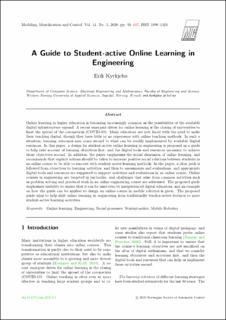| dc.contributor.author | Kyrkjebø, Erik | |
| dc.date.accessioned | 2020-12-07T08:23:03Z | |
| dc.date.available | 2020-12-07T08:23:03Z | |
| dc.date.created | 2020-09-09T12:28:14Z | |
| dc.date.issued | 2020 | |
| dc.identifier.citation | Kyrkjebø, E. (2020). A guide to student-active online learning in engineering. Modeling, Identification and Control: A Norwegian Research Bulletin, 41(2), 91–107. | en_US |
| dc.identifier.issn | 0332-7353 | |
| dc.identifier.uri | https://hdl.handle.net/11250/2712078 | |
| dc.description.abstract | Online learning in higher education is becoming increasingly common as the possibilities of the available digital infrastructure expand. A recent emergent driver for online learning is the closing of universities to limit the spread of the coronavirus (COVID-19). Many educators are now faced with the need to make their teaching digital, though they have little or no experience with online teaching methods. In such a situation, learning outcomes may come second to what can be readily implemented by available digital resources. In this paper, a design for student-active online learning in engineering is proposed as a guide to help take account of learning objectives first, and the digital tools and resources necessary to achieve those objectives second. % in when choosing online learning strategies. In addition, the paper emphasises the social dimension of online learning, and recommends that explicit actions should be taken to increase positive social relations between students in an online course to be able to succeed with student-active learning methods. In the paper, a clear path is followed from objectives to learning activities, and then to assessments and evaluations, and appropriate digital tools and resources are suggested to support activities and evaluations in an online course. Online courses in engineering are targeted in particular, and challenges that arise from common activities such as problem solving and practical work in an online engineering course are addressed. The proposed guide emphasises usability to ensure that it can be used even by inexperienced digital educators, and an example on how the guide can be applied to design an online course in mobile robotics is given. The proposed guide aims to help shift online learning in engineering from traditionally teacher-active lectures to more student-active learning activities. | en_US |
| dc.language.iso | eng | en_US |
| dc.publisher | Institutt for teknisk kybernetikk | en_US |
| dc.rights | Navngivelse 4.0 Internasjonal | * |
| dc.rights.uri | http://creativecommons.org/licenses/by/4.0/deed.no | * |
| dc.subject | online learning | en_US |
| dc.subject | engineering | en_US |
| dc.subject | social processes | en_US |
| dc.subject | student-active | en_US |
| dc.subject | mobile robotics | en_US |
| dc.title | A Guide to Student-active Online Learning in Engineering | en_US |
| dc.type | Peer reviewed | en_US |
| dc.type | Journal article | en_US |
| dc.description.version | publishedVersion | en_US |
| dc.rights.holder | © 2020 Norwegian Society of Automatic Control | en_US |
| dc.source.pagenumber | 91-107 | en_US |
| dc.source.volume | 41 | en_US |
| dc.source.journal | Modeling, Identification and Control | en_US |
| dc.source.issue | 2 | en_US |
| dc.identifier.doi | 10.4173/mic.2020.2.5 | |
| dc.identifier.cristin | 1828380 | |
| dc.relation.project | Norges forskningsråd: 280771 | en_US |
| cristin.ispublished | true | |
| cristin.fulltext | original | |
| cristin.qualitycode | 1 | |

